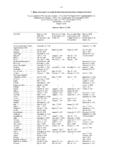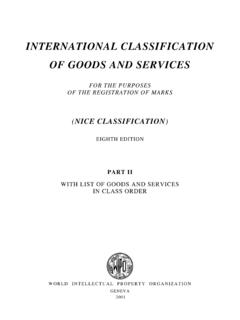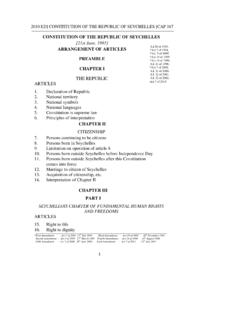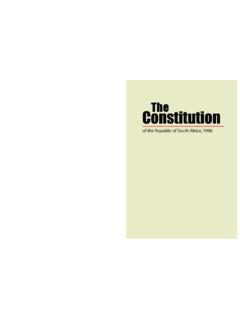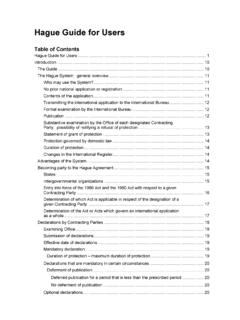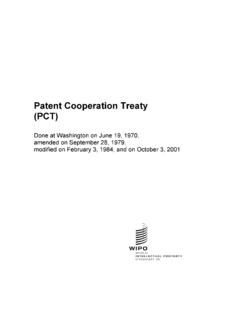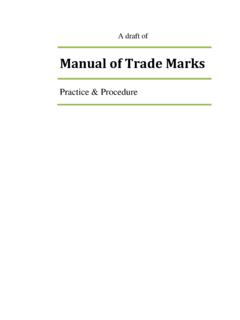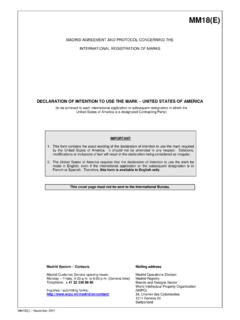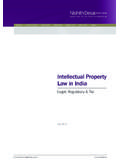Transcription of Chapter 5 International Treaties and Conventions …
1 Chapter 5 International Treaties and Conventions on intellectual Property The Paris convention for the Protection of Industrial Property History Principal Provisions Administrative and Financial Provisions The Berne convention for the Protection of Literary and Artistic Works History Principal Provisions The Latest (Paris) Act of the convention Administration Developing Countries and the Berne convention The WIPO Copyright Treaty (WCT) Introduction Legal Nature of the WCT and its Relationship with Other International Treaties Substantive Provisions of the WCT Administrative Provisions The Patent Cooperation Treaty (PCT)
2 Introduction The Functioning of the PCT System Advantages of the PCT System Budapest Treaty on the International Recognition of the Deposit of Microorganisms for the Purposes of Patent Procedure Background to the Treaty Summary of the Treaty Main Advantages of the Treaty The Madrid Agreement Concerning the International Registration of Marks and the Protocol Relating to the Madrid Agreement Introduction The Functioning of the System of International Registration Becoming Party to the Agreement or Protocol Advantages of the System The Hague Agreement Concerning the International Deposit of Industrial Designs Introduction The Principle of International Deposit Main Provisions of the Hague Agreement Benefits of Accession to the Hague Agreement The Geneva Act of the Hague Agreement The Trademark Law Treaty (TLT) Introduction Provisions of the Treaty and the Regulations The Patent Law Treaty (PLT)
3 Introduction Provisions of the Treaty and the Regulations Advantages of the PLT Treaties on Classification Introduction The Strasbourg Agreement Concerning the International Patent Classification The Nice Agreement Concerning the International Classification of Goods and Services for the Purposes of the Registration of Marks The Vienna Agreement Establishing an International Classification of the Figurative Elements of Marks The Locarno Agreement Establishing an International Classification for Industrial Designs Special Conventions in the Field of Related Rights: The International convention for the Protection of Performers, Producers of Phonograms and Broadcasting Organizations ( the Rome convention )
4 Introduction Relation between the Protection of Related Rights and Copyright Principal Provisions The Implementation of the Rome convention The Rome convention and Developing Countries Other Special Conventions in the Field of Related Rights The Other Special Conventions Reasons for and Purposes of the Special Conventions Main Features of the Special Conventions Substantive Provisions of the Phonograms convention Substantive Provisions of the Satellites convention The Phonograms and Satellites Conventions and Developing Countries The WIPO Performances and Phonograms Treaty (WPPT) Introduction Legal Nature of the WPPT and its Relationship with Other International Treaties Substantive Provisions of the WPPT Administrative Provisions Audiovisual Performances The International convention for the Protection of New Varieties of Plants Introduction The International Union for the Protection of New Varieties of Plants (UPOV) The 1991 Act of the UPOV convention Developments in Plant Variety Protection The Agreement on Trade-Related Aspects of intellectual Property Rights ( TRIPS )
5 And WIPO-WTO Cooperation Introduction General Provisions, Basic Principles and Final Provisions (Parts I and VII) Standards Concerning the Availability, Scope and Use of intellectual Property Rights (Part II) Enforcement of intellectual Property Rights (Part III) Acquisition and Maintenance of intellectual Property Rights and Related Procedures (Part IV) Dispute Prevention and Settlement (Part V) Cooperation between the World intellectual Property Organization and the World Trade Organization Progressive Development of International intellectual Property Law Introduction The Joint Recommendation Concerning Provisions for the Protection of Well-Known Marks The Joint Recommendation Concerning Trademark Licenses The Joint Recommendation Concerning the Protection of Marks, and Other Industrial Property Rights in Signs, on the Internet 240 WIPO intellectual Property Handbook.
6 Policy, Law and Use Chapter 5 - International Treaties and Conventions on intellectual Property 241 The Paris convention for the Protection of Industrial Property History During the last century, before the existence of any International convention in the field of industrial property, it was difficult to obtain protection for industrial property rights in the various countries of the world because of the diversity of their laws. Moreover, patent applications had to be made roughly at the same time in all countries in order to avoid a publication in one country destroying the novelty of the invention in the other countries. These practical problems created a strong desire to overcome such difficulties.
7 During the second half of the last century the development of a more internationally oriented flow of technology and the increase of International trade made harmonization of industrial property laws urgent in both the patent and the trademark field. When the Government of the Empire of Austria-Hungary invited the other countries to participate in an International exhibition of inventions held in 1873 at Vienna, participation was hampered by the fact that many foreign visitors were not willing to exhibit their inventions at that exhibition in view of the inadequate legal protection offered to exhibited inventions. This led to two developments: firstly, a special Austrian law secured temporary protection to all foreigners participating in the exhibition for their inventions, trademarks and industrial designs.
8 Secondly, the Congress of Vienna for Patent Reform was convened during the same year, 1873. It elaborated a number of principles on which an effective and useful patent system should be based, and urged governments to bring about an International understanding upon patent protection as soon as possible. As a follow-up to the Vienna Congress, an International Congress on Industrial Property was convened at Paris in 1878. Its main result was a decision that one of the governments should be asked to convene an International diplomatic conference with the task of determining the basis of uniform legislation in the field of industrial property. Following that Congress, a final draft proposing an International union for the protection of industrial property was prepared in France and was sent by the French Government to a number of other countries, together with an invitation to attend the 1880 International Conference in Paris.
9 That Conference adopted a draft convention which contained in essence the substantive provisions that today are still the main features of the Paris convention . A Diplomatic Conference was convened in Paris in 1883, which ended with final approval and signature of the Paris convention for the Protection of Industrial Property. The Paris convention was signed by 11 States: Belgium, Brazil, El Salvador, France, Guatemala, Italy, the Netherlands, Portugal, Serbia, Spain and Switzerland. When it came into effect on July 7, 1884, Great Britain, Tunisia and Ecuador had adhered as well, bringing the initial number of member countries to 14. El Salvador, Guatemala and Ecuador later denounced the Paris convention to join again in the 1990s.
10 It was only during the first quarter of the 20th century and then particularly after World War II that the Paris convention increased its membership more significantly. The Paris convention has been revised from time to time after its signature in 1883. Each of the revision conferences, starting with the Brussels Conference in 1900, ended with the adoption of 242 WIPO intellectual Property Handbook: Policy, Law and Use a revised Act of the Paris convention . With the exception of the Acts concluded at the revision conferences of Brussels (1897 and 1900) and Washington, (1911), which are no longer in force, all those earlier Acts are still of significance, although the great majority of the countries are now party to the latest Act, that of Stockholm of 1967.

